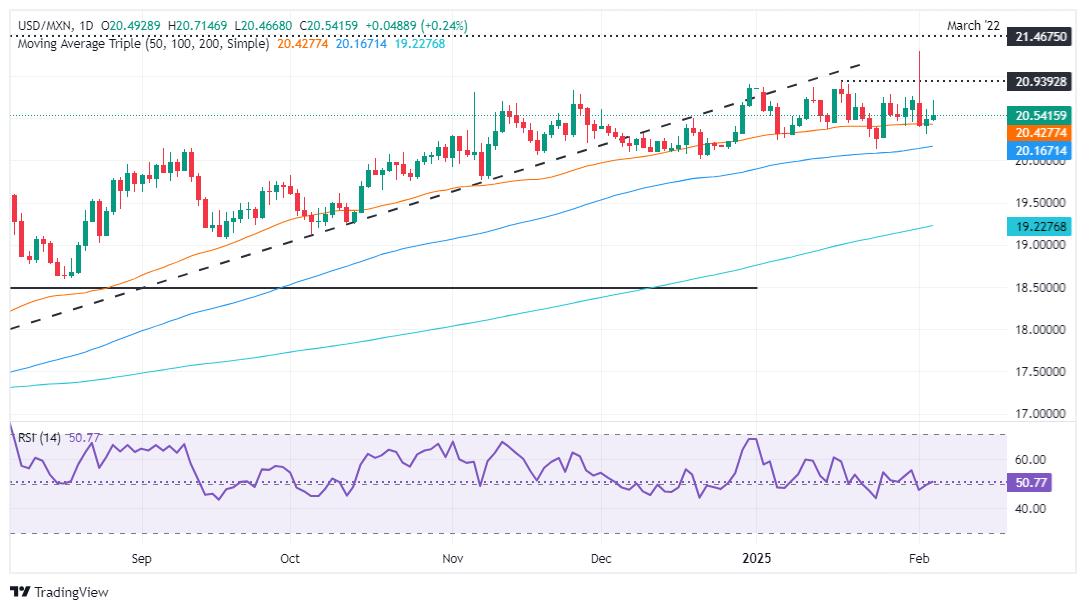Mexican Peso dives unaided by weak US Dollar

- The Mexican Peso depreciates as USD/MXN climbs above 20.50 as trade tensions between the US and Mexico ease.
- Mixed investment data and anticipated Banxico rate cut further pressure on the Mexican Peso.
- The White House clarifies trade measures with Mexico, focusing on anti-drug efforts.
The Mexican Peso (MXN) dropped for the second straight day versus the US Dollar (USD) as trade war fears began to fade. Upbeat United States (US) jobs data pressured the Mexican currency, which has failed to capitalize on broad US Dollar weakness. The USD/MXN trades at 20.57, up by 0.45%.
Mexico’s economic docket revealed mixed Gross Fixed Investment figures in November. The data underscores the ongoing economic slowdown and undermines the already battered Mexican Peso, which could weaken further as the Banco de Mexico (Banxico) is expected to lower interest rates by at least 25 basis points from 10% to 9.75% on Thursday.
Although trade disputes between the US and Mexico have found common ground, USD/MXN traders should know that there is a 30-day pause and that tensions could arise throughout the end of February. Peter Navarro, a trade adviser for the White House, said that Canada misunderstood that it is not a “trade war” but a drug war.
Therefore, tariffs on Mexico will remain paused if the Government improves on its fight against drug cartels.
In the US, data keeps the Greenback on the back foot. The Institute for Supply Management (ISM) revealed that business activity in the US services sector cooled down in January. Other data showed that the jobs market remains solid as traders prepare for the release of US Nonfarm Payrolls numbers on Friday.
Daily digest market movers: Mexican Peso remains heavy amid broad USD weakness
- Gross Fixed Investment in Mexico rose 0.1% MoM in November, down from 0.3% in October, but exceeded forecasts of -0.1%. On a yearly basis, it improved from -2.6% contraction to -0.7%.
- Mexico’s Business Confidence in January showed signs of improvement, though business activity contracted, according to S&P Global. The manufacturing sector contracted for the seventh straight month in January, indicating that the economy is slowing down
- Banxico’s private economists survey showed that Mexico’s economy is expected to grow by 1% in 2025, down from 1.2% in the December survey. Inflation is expected to tick higher from 3.80% to 3.83%, while core prices are foreseen at 3.74%, up from 3.72%.
- Economists estimate the USD/MXN pair exchange rate to finish the year at 20.90, up from 20.53 in December, and estimate 150 basis points of easing from Banxico.
- The US ADP National Employment Change in January grew from 176K to 183K, exceeding estimates of 150K.
- The ISM Services PMI, for the same period as the ADP, rose 52.9 and exceeded forecasts of 52.8 but dipped compared to December’s 54.0.
- S&P Global featured Services PMI for January, which dipped from 56.8 to 52.9, better than the 52.8 expected.
- Money market fed funds rate futures are pricing in 52 basis points (bps) of easing by the Federal Reserve in 2025.
USD/MXN technical outlook: Mexican Peso weakens past 20.50 as buyers target 20.90
USD/MXN rose 0.265, recovering from a weekly low of 20.30 on Monday. Nevertheless, buyers’ inability to achieve a daily close below the 50-day Simple Moving Average (SMA) of 20.41 sponsored the buck’s recovery to the detriment of the Peso.
For a bullish resumption, buyers must clear the previous year-to-date (YTD) peak of 20.90, ahead of the 21.00 figure. Further upside lies above the current YTD peak of 21.29.
Conversely, if sellers push USD/MXN below 20.30, it could fall to the 100-day SMA at 20.15. ahead of the 20.00 figure.
Tariffs FAQs
Tariffs are customs duties levied on certain merchandise imports or a category of products. Tariffs are designed to help local producers and manufacturers be more competitive in the market by providing a price advantage over similar goods that can be imported. Tariffs are widely used as tools of protectionism, along with trade barriers and import quotas.
Although tariffs and taxes both generate government revenue to fund public goods and services, they have several distinctions. Tariffs are prepaid at the port of entry, while taxes are paid at the time of purchase. Taxes are imposed on individual taxpayers and businesses, while tariffs are paid by importers.
There are two schools of thought among economists regarding the usage of tariffs. While some argue that tariffs are necessary to protect domestic industries and address trade imbalances, others see them as a harmful tool that could potentially drive prices higher over the long term and lead to a damaging trade war by encouraging tit-for-tat tariffs.
During the run-up to the presidential election in November 2024, Donald Trump made it clear that he intends to use tariffs to support the US economy and American producers. In 2024, Mexico, China and Canada accounted for 42% of total US imports. In this period, Mexico stood out as the top exporter with $466.6 billion, according to the US Census Bureau. Hence, Trump wants to focus on these three nations when imposing tariffs. He also plans to use the revenue generated through tariffs to lower personal income taxes.
